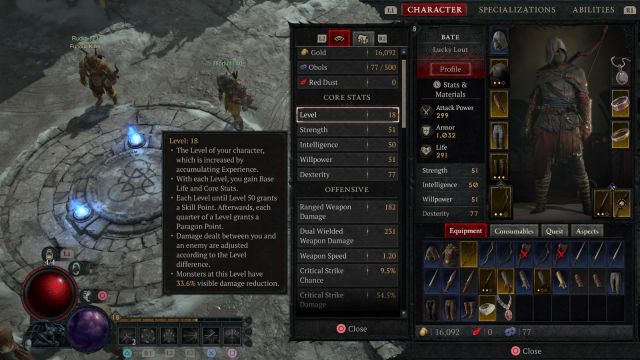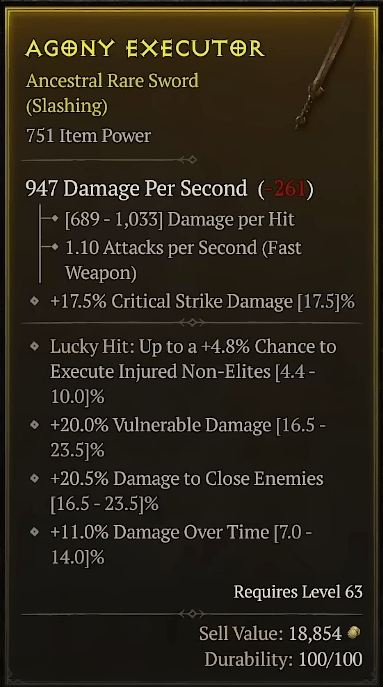Diablo 4 throws plenty of different stats at players, from attack power to defenses and resistances, but one of the most important factors of the game players want to know is the damage bucket system. However, the system can be confusing for anyone without prior understanding.
A successful release for Diablo 4 has seen the popularity of the game surge, though there are likely to be many who have no idea what damage buckets in the game are.
It’s definitely a complicated topic and one that requires a bit of a deeper understanding of the mechanics of the game, though it can be explained in simpler terms.
We’re here to do exactly that with an explanation of how damage buckets work in Diablo 4.
What are damage buckets in Diablo 4?

In layman’s terms, damage buckets are the calculations that work out how much damage output your character has, but, given the complexities of different crowd controls and afflictions in Diablo 4, there is plenty to digest.
Overall, there are six known damage buckets. These are Main Stats, [X] Percent Damage, Attack Speed Bonus, Critical Strike, Additive Damage, and Vulnerable Damage.
Main Stats is as simple as it sounds, worked out via the raw stats of a character, while the [X] percent damage is further damage on top of that. While Attack Speed Bonus doesn’t affect your damage numbers specifically, it does help you cast your abilities more often.
Related: Stats in Diablo 4, explained in detail
Critical Strike is the damage output when landing—you guessed it—a Critical Strike, while Additive Damage is the various different damage outputs you have against specifics like Elites, Chilled Enemies, Poisoned Enemies, and the like.
Vulnerable Damage is similar to Additive Damage and is the damage output you get against enemies with the Vulnerable status.
Do different classes have different damage buckets in Diablo 4?
Essentially, yes—although a lot of these are transferable. Attack Speed Bonus, Critical Strikes, and Vulnerable Damage are the same across all classes, though there are a number of other differences.
Each class has its own Main Stat, while the Additive Damage varies depending on your class and build. For example, the Barbarian has Additive Damage while Berserking and while Fortified, while the Druid has Additive Damage while Werebear and while Werewolf.
This allows greater build control, as you’ll be able to see what specific items do in different situations. For example, my Rogue build focuses on making as many enemies Vulnerable as possible, and, using the damage buckets, I can see what my Critical Strike Chance and Damage are against Vulnerable enemies.
| Class | Primary Stat |
| Barbarian | Strength |
| Druid | Willpower |
| Necromancer | Intelligence |
| Rogue | Dexterity |
| Sorcerer | Intelligence |
You’ll want to use the damage buckets to enhance your build in similar ways, either against specific Crowd Controlled types or while in a specific form, like a Druid. Maximizing the damage output and the number of times you can put yourself in such a situation can drastically improve your build overall.
How to increase damage output in Diablo 4

Now you have a bit more understanding of how damage works in Diablo 4, it can be used to your advantage to increase your damage output using the formulas that the game uses to calculate damage.
The most basic formula is Damage = BaseDMg x (1+AddDMG) x (1+MultiDMG) x (1.2 + Vulnerable percentage) x (1+CritChance x CritDMG) + OverpowerDMG.
Confused yet? Don’t worry, I was too as maths is not my strong point, but the algebra calculations can be broken down into much simpler ways of increasing your damage output.
The easiest way to improve damage is by increasing Base Damage. This will happen over time as you progress through the game but can be increased by improving your Main Stat, shown for specific classes in the table in this article.
You’ll also want to have a variety of Additive sources to your damage, against things like Vulnerable, Poisoned, Chilled enemies, and the like, but by far the best way of improving your overall damage output is in the final point.
Use any way you can to get easier access to Critical Strikes and inflict Vulnerable upon enemies. With the former, you want to increase both the Critical Strike Chance, which is how often you get these harder hits against enemies, and Critical Strike Damage, which is exactly what it sounds like.
For Vulnerable, you’ll want to afflict this onto as many enemies as possible. Vulnerable is afflicted per cast, so if you have an AoE attack, it will be inflicted across all enemies in the vicinity, and there are abilities and affixes that can assist you in transferring the affliction to even more enemies.
The good thing is you can respec your character as many times as you want, though you’ll have to have enough gold to do so. Switch things about and see what works best for you, which will eventually lead you to your perfect build.













Published: Jun 23, 2023 09:27 pm